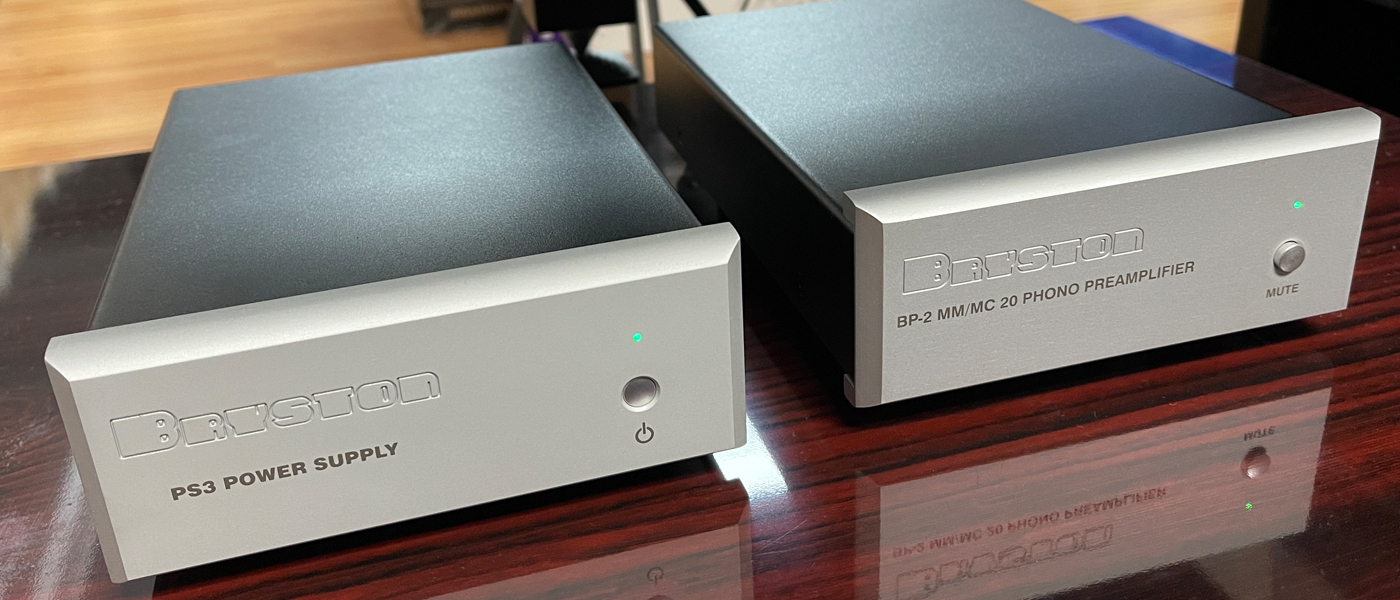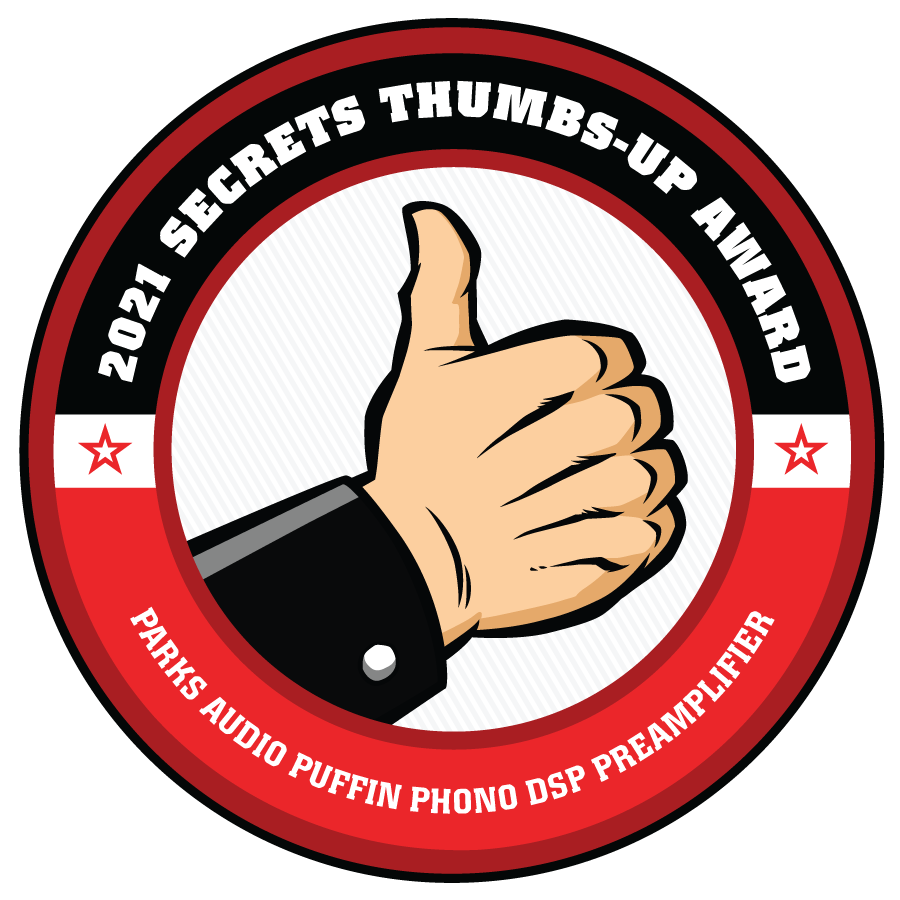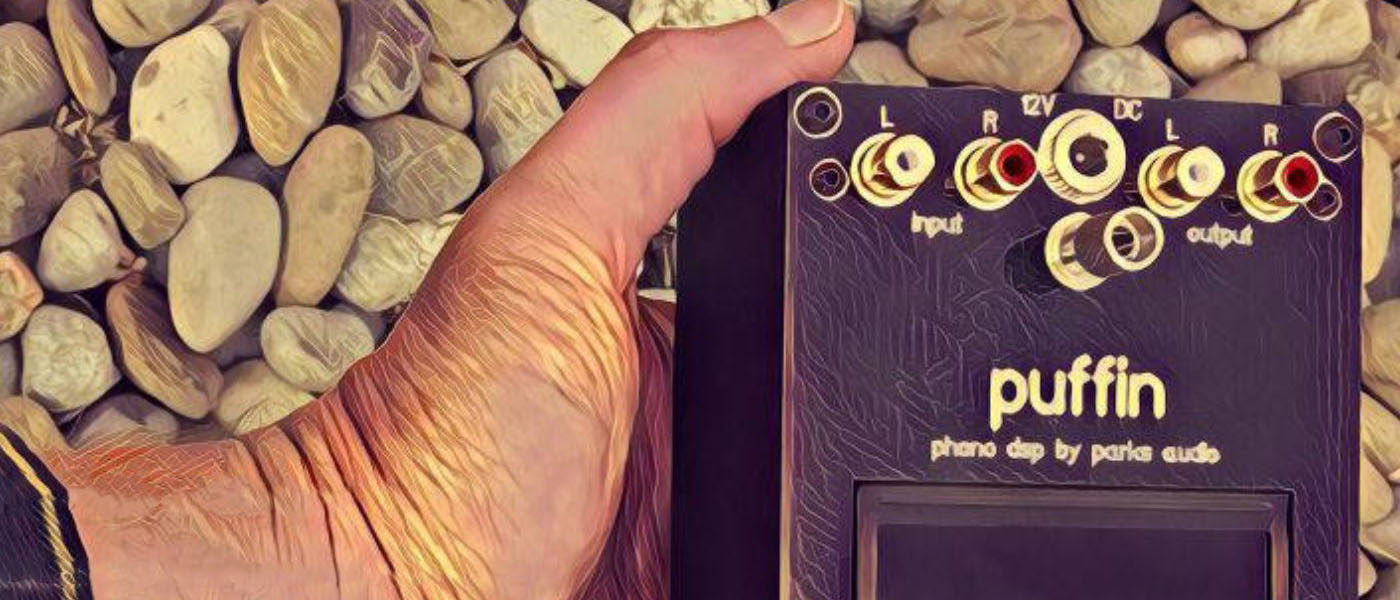
And for a lot of analog enthusiasts, adding digital circuitry to an analog signal path is downright heresy. But the analog playback experience can be greatly enhanced with what digital signal processing (DSP) and software can provide. It’s just that, to the best of my knowledge, not a lot of companies are providing this functionality right now. And if they are, their components are not sold for easily affordable prices. But Shannon Parks’s Puffin does use a DSP and software, and he sells it for a relatively affordable price.
Parks Audio Puffin Phono DSP Preamplifier
- Very attractive price, considering the amount of functionality it provides
- Its software can be upgraded by the owner
- It’s available with a digital output, so you can run your phono output through a DAC
- It’s designed and built in a family-owned facility in the USA
- Shannon Parks is responsive to requests for information and support
Shannon Parks of Parks Audio has extended what a phono preamplifier is capable of with his compact and clever Puffin DSP phono preamplifier. The Puffin will play the output of essentially any kind of phono cartridge, whatever its power output or load requirements are. The Puffin will let you equalize its output for a very wide variety of vinyl EQ settings, such as those found on Columbia 78rpm records, Teldec/DGG LPs, or the standard RCA RIAA curves. And if you happen to have an album that was mastered out of phase, the Puffin will let you correct that as well.
And, believe it or not, that’s just a few of the functions the Puffin is capable of. You can equalize the output for your room’s acoustics, play mono records with a mono cart, grade the quality of a record, and even keep track of the playing hours of your cartridge. And, as if that weren’t enough, you can buy a version of the Puffin that will send a 96 kHz/24-bit S/PDIF output signal to a DAC through a digital coax or TOSLINK cable.

The Parks Audio Puffin is a Swiss Army knife for vinyl enthusiasts. It can work with an endless variety of turntable configurations. I honestly can’t think of a single type of phono cartridge or vinyl (or shellac) record the Puffin can’t improve. Whether it’s a 7-inch, 10-inch, or 12-inch vinyl record, to be played at 16, 33, or 45rpm, or a shellac record to be played at 78rpm, the Parks Audio Puffin can help you fine-tune and tweak your cartridge and get every last drop of musical detail out of the record’s grooves.
The Puffin will also let you do several other very useful things that you did not know you needed. For example, it can grade records. It will use its software to compare the number of pops and clicks versus the time of silence and give you a letter grade. It will convert its output to mono, which is essential if you listen to mono recordings and your preamplifier does not have a mono switch. (You can also do this with a CD player’s output as well. Neat!)
And the list of the Puffin’s capabilities keeps growing. Just recently added is the ability to adjust your cartridge’s azimuth settings. The Puffin will display the output of each channel in real-time while you play a test record, so you adjust the azimuth setting of your cartridge over and over until you get the output readings for both channels as close to each other as you can. And if you are a visual learner like I am, Shannon Parks has a very easy-to-follow demonstration of this procedure on his YouTube channel.
All of this functionality comes from a single black box with two buttons, one adjustment knob, an LCD screen, and one RCA input. And the price starts at $489 (the unit I am reviewing, with TOSLINK output, sells for $639). But how does it sound? How easy is it to use a Puffin when you have multiple turntables and cartridges? Let’s find out.
COMPATIBILITY:
Works with all record players and cartridges. Suitable gain settings (-4dB to 72dB) for moving coil carts (0.25mV), high-output mobile coil carts (2mV), all the way to CDs and DACs (2V).
MAXIMUM INPUT AND OUTPUT:
2Vrms
INPUT IMPEDANCE:
47k ohms (50pF) selectable to 200 ohms (1nF) for moving coil cartridges
OUTPUT IMPEDANCE:
1k loads and up, but will drive some sensitive headphones
ANALOG GAIN STAGE:
NJM2122M
ANALOG-TO-DIGITAL CONVERTER:
Texas Instruments PCM1808
DIGITAL-TO-ANALOG CONVERTER:
Texas Instruments PCM5102A
DIGITAL SIGNAL PROCESSOR:
ARM Cortex M4 80MHz with 32-bit FPU
DIGITAL CONVERSION RATE:
24-bit resolution at 96kHz sampling rate
DIMENSIONS:
5.75” long x 3.5” wide x 2” tall
TOP PANEL:
Red LCD display with two buttons and a selection knob
One pair of RCA inputs
One pair of RCA outputs
DC power input
Grounding terminal
REAR PANEL:
Optical TOSLINK S/PDIF port, if equipped
MSRP:
$489
$589, with 96kHz/24-bit digital coax output
$639, with 96kHz/24-bit optical TOSLINK output
Website:
Company:
SECRETS Tags:
Parks Audio, DSP, phono, preamplifier, mono, stereo, DAC, digital, converter, Reviews 2021
Parks Audio is owned and run by Shannon Parks, and he’s been in the audio business for quite a while. He’s also been very active in the DIY scene, both through his diytube.com web forum and the DIY kits he’s produced. One such kit was the Get*Set*Go single-ended tube amplifier, inspired by the JE Labs 2A3 amplifier designed by Joseph Esmilla. That particular amp’s power output was three watts, which tells me that Parks has a sharp mind for the intricacies of circuit design and component matching.

Then there were the phono preamplifiers. First, there was the Budgie, which was sold as a standalone step-up transformer, and then later as a tubed phono preamplifier with sixteen different loading choices. These units could be purchased as kits, which made them attainable for tinkerers and enthusiasts with smaller budgets. It’s worth noting that it is not easy finding a used Budgie; the people who bought them don’t often sell them off.
Secrets Sponsor
I think these things show that Shannon Parks is an engineer who is clearly dedicated to the art and science of the playback of vinyl. He improves his components throughout their lifetimes, listens to his customers, and implements improvements when possible. I have found him to be very easy to contact and communicate with, and he’s quick to give great advice and answers when asked. Much like Schiit Audio, I feel much better purchasing a component when I know it is easy to get customer support.
So how does the Puffin work? Let’s review the Puffin’s overall circuit design. Shannon Parks was good enough to send me a diagram that explained this to me very clearly.
First, the analog audio input signal from the cartridge feeds a low noise NJM2122M Op-Amp. From there the signal travels to a Texas Instruments PCM1808 analog-to-digital converter. Next, it feeds the digital signal processor, which is an ARM Cortex M4 80MHz with 32-bit FPU. Here is where the signal is buffered and processed according to user input, and it is processed at a 96kHz/24-bit bitrate. Finally, the digital signal processor sends the processed signal to either an analog RCA output or digital S/PDIF output, depending on how you have configured the Puffin.
So, before I put the Parks Audio Puffin into my system I knew it has a lot of configuration options. Fortunately, a very well-written manual is included, and it covers all of what the Puffin is capable of very clearly. And Shannon Parks was thoughtful enough to include a quick-start tip sheet to help you get started with minimal effort after you install the Puffin in your system.
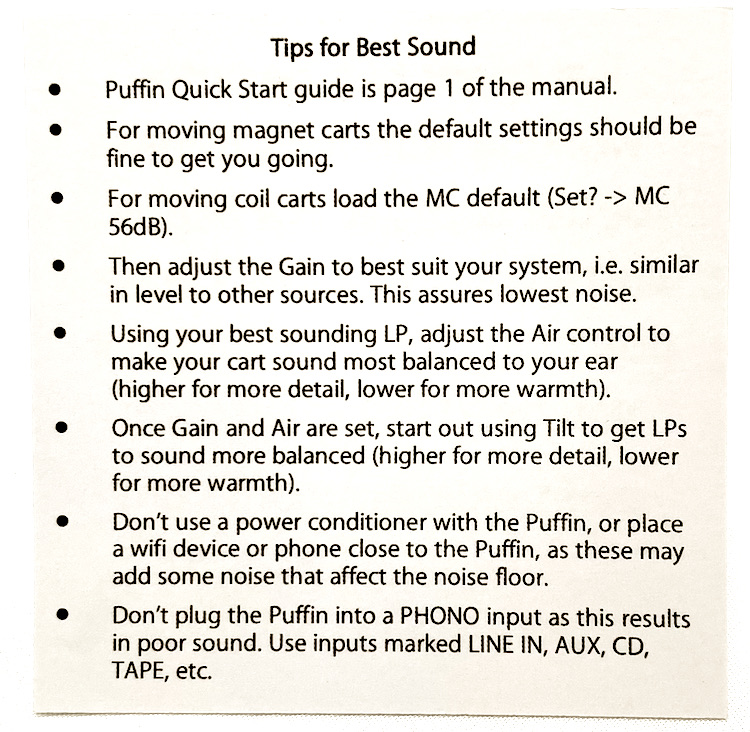
So that’s how I did it at first. I plugged the phono cable from the Jelco SA-750LB tonearm on my Garrard 301 turntable into the Puffin. I attached a headshell with a Denon DL-103 cartridge installed in it onto the tonearm (and I attached the tonearm’s grounding cable to the Puffin as well). And then I sent the output of the Puffin into the marvelous Schiit Audio Freya + preamp.
The Puffin is powered with a wall-wart DC power supply. Shannon Parks urges you not to plug it into a power conditioner or near a WiFi device or phone, as those may add noise that would affect the noise floor. So, I took Parks’s advice and plugged it straight into a wall outlet.
Every phono preamplifier I’ve used was a set-it-and-forget-it affair. You attach your cables, configure the preamp for the cartridge, if possible, turn it on, then sit down and listen. You generally do not interact with the phono preamp after you’ve dialed it in. But with the Puffin, you can fiddle around with quite a few settings to change the sound as you play music. Granted, the Old School Way of playing records says that you should keep the signal path as simple and pure as possible, but I quite like this New School Way of playing records. In that regard, the Parks Audio Puffin represents an entirely new paradigm for me.
The Puffin’s default settings are good for moving-magnet (MM) carts, whose output is usually around 3mv to 5mV. But I was starting with a low-output MC cart; the Denon DL-103’s output is only 0.3mV, so I would have to adjust the Puffin. But you know what? It sounded pretty good with the default settings, but that was just a quick cursory listen to ensure everything was working.
Shannon Parks thoughtfully includes a list of load and gain settings for 24 popular cartridges from Audio-Technica, Denon, Dynavector, and so on. And that list includes the recommended settings for the Denon DL-103: 64db of gain with a load of 200 ohms. So I input those settings into the Puffin, started the Garrard, dropped the needle on the record one more time, and listened.
I honestly had no expectations as to what kind of sound quality the Puffin would be capable of, as it is unlike any other component I’ve ever had in my system. And I can honestly say that I was surprised at how energetic and lively its sound was. The Denon DL-103 cartridge is popular for its low price point ($300US), and I’ve owned a number of them over the years. I find its 0.2mm spherical diamond tip quite adept at playing music with energy and detail, and, even though it can sound a bit analytical at times, that is a quality I enjoy in vinyl playback.
And the qualities of the DL-103 were all easy to hear when played through the Puffin. But where it really got fun was when I began adjusting the Puffin’s settings while the music was playing. To begin with, I toggled between the 200 ohms and 47K load settings and heard a noticeable difference in gain, which means I could fine-tune the DL-103 cartridge’s output for whatever preamplifier I happen to be using in my system at the time. I also adjusted the “Air” setting; increasing it provided slightly more detail and air in the sound quality, and decreasing it added warmth and smoothness. I immediately began to understand how the Puffin can be used to adjust, change, or improve the sound of a phono cartridge.
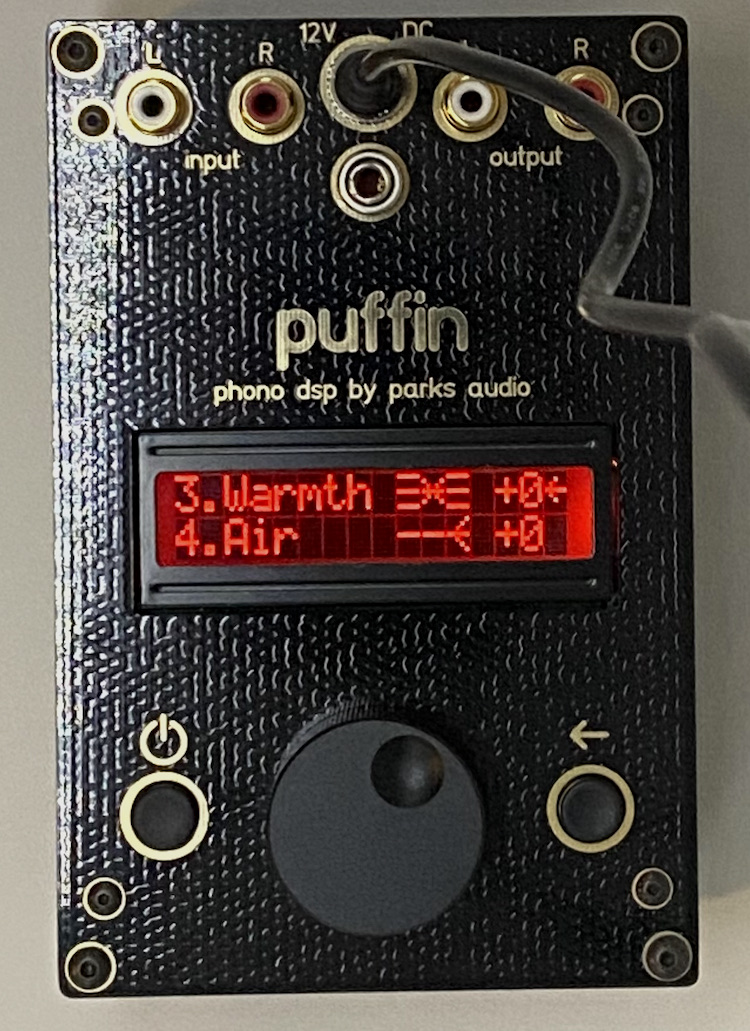
After I had used the Parks Audio Puffin in my system for a while, something occurred to me. This thing is fun!
I own ten different vinyl pressings of Frank Sinatra’s “Songs for Swingin’ Lovers.” Each one was pressed between the mid-1950s to the mid-1970s, so their conditions range from poor to very good. Not one of them would qualify as better than Very Good Plus (VG+). As you know, it’s very difficult to find very clean copies of popular albums that are that old. That means that a number of these albums I bought because of what they are (cover variations, different Capitol Records pressings, and so on) rather than how they sound because some of them are so damaged they really aren’t worth listening to.
Or so I thought before I had a Parks Audio Puffin in my system. It has a very clever function called “Magic,” which according to the Puffin’s manual, “gently lessens many of the small pops and clicks normally heard during playback. It consists of a click detector that monitors the music for outlier, transient sound events which are then flagged. An algorithm then determines whether the flagged event was likely noise or musical in nature – perhaps a trumpet or drum snare. Once it has been determined that the event was noise, a selective filter is engaged for around half a millisecond. So, the Magic function is not processing 100% of the audio like a normal DSP filter, and actually may be only filtering a few seconds of audio per album side. This gentle method makes the record sound cleaner with fewer artifact distractions, and doesn’t have a processed sound at all since very little processing is actually done. It will make your best records sound transcendent and some of the well-worn ones will be much more listenable. It is recommended to be left on all the time.”
Another nifty feature of the Puffin for mono recordings is that it will let you select stereo, mono, or either the left or right channel. As you may know, with mono recordings the information in the left and right channels is identical. But if, say, the album you’re listening to was played in the 1960s by a teenager who taped a penny to the top of the headshell, and that ended up damaging the right channel, it could be that the left channel is in perfect shape. With the Puffin you can try each channel and may end up listening to a perfectly clean mono record you didn’t know you had.
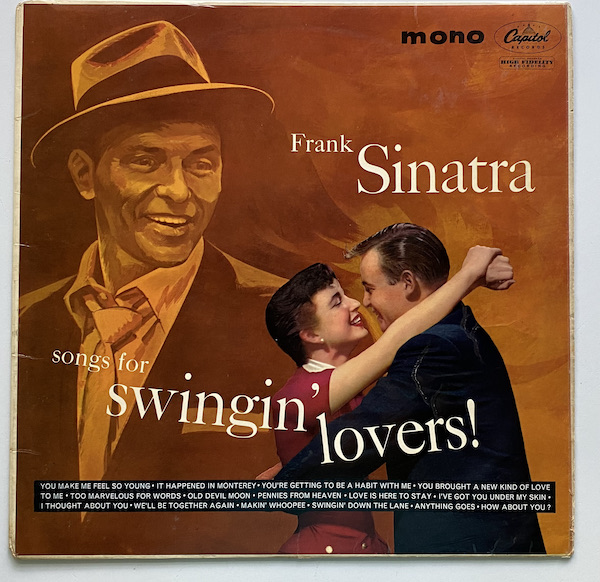
And you know what? The “Magic” really worked. Some of my Sinatra albums are so scratched and dirty that you’d think there’s really no way to rehabilitate them, either with cleaning or software. But I can safely say that a combination of the Puffin’s “Magic” functionality and its channel segregation ability improved the sound quality (or removed so much noise) so well that the albums became enjoyable to listen to. For example, the Puffin graded one of my copies of “Songs for Swingin’ Lovers” as D+, but when I listened to it through only the left channel with “Magic” enabled, a good 80% of the noise disappeared and much more of the music than I’ve ever heard with that album came through. Miraculous.
And yes, the Puffin enables you to save four settings configurations in its non-volatile memory. So you can have a preset for a particular cartridge to play a particular album on a particular tonearm, for example. That’s just nifty.
Parks provides a well-written set of instructions for updating the Puffin’s firmware here. You essentially download a file and, depending on whether you’re using a Windows or macOS computer, use a program or the command line to install the new firmware.
The Puffin has a USB-Micro port on a small board on its main circuit board. To open the Puffin, you remove four corner screws with an Allen wrench that Parks includes, pull away the top covering, then attach the USB-Micro cable between the Puffin and your computer. And the Puffin does not have to be powered on with its DC power supply for this as it will draw power from the computer’s USB hub.
As of this writing, the Puffin’s firmware is at version 1.30 beta A, and the update included an impressive number of additions. Improvements to the speed and azimuth testing functionality and a simplified way to access your most-used functions on a shorter menu list are just two of them. Most impressive is a cartridge timer that logs the hours, minutes, and seconds of your cart’s actual playing time up to 10,000 hours.
It’s worth pointing out that Parks renamed one of the menu items from “Tilt” to “Warmth.” In the readme page for the firmware update, Parks writes, “Tilt isn’t an intuitive control name – though truly descriptive of the actual filter and known in the audio realm by some. Meanwhile, Warmth tells us a bit more about itself and intuitively a higher value will be ‘warmer.’ But the functionality is the same other than it is inverted from the previous Tilt settings (e.g. Tilt -3 is now Warmth +3).” I appreciate the fact that Shannon Parks regards the Puffin as a living, evolving device, and that he solicits and incorporates customer feedback when possible. Parks can add or change features through the Puffin’s software, without having to replace physical components, and I would honestly like to see more of this attitude and practice in contemporary stereo components.

In my main system, I use a Garrard 301 turntable with two tonearms installed. While this affords me a lot of flexibility with the cartridges I use (both of the tonearms have removable headshells), finding a phono preamplifier with two adjustable inputs for less than $1000US is not easy.
Fortunately, the Parasound Zphono XRM fits that bill, so I bought one. It sells for $595US and includes a rumble filter, a mono switch (which are also difficult to find in phono preamplifiers nowadays, and I frequently listen to mono LPs with a mono cartridge), and inputs for both moving coil and moving magnet cartridges. Also important to me are that I can switch gain from 50db to 60db with a toggle switch, and I can adjust load impedance with a rotary switch. A few years back I decided that my life was too short to spend time changing settings in a phono preamplifier by flipping dip switches or moving jumpers on a circuit board.
I also use a Ray Samuels Audio Emmeline F-117 Nighthawk phono preamplifier. This is a single input phono stage with four rotary switches on the front to adjust load and gain for the right and left channels, and it’s powered by an internal lithium battery. With its $795 MSRP, it is a true giant killer. It does a very good job getting low-level information out of records.
In terms of sound quality, the F-117 Nighthawk is the best I have, because it’s best at retrieving low-level detail. For example, I can hear more air around a cymbal after it is struck, and I can hear the cymbal’s vibrations fade away for a longer period than I can with the Zphono XRM. But the Zphono XRM is only slightly less capable in that regard, in that I don’t hear the cymbal fade away for so long, but both preamps are good at maintaining the pacing and rhythm of vinyl, so I can hear the intent of the musicians. So what little I lose in sound quality with the Zphono XRM I gain in convenience with its two phono inputs. In this price range, tradeoffs are inevitable.
Secrets Sponsor
When I compared the Parks Audio Puffin to these two other phono preamplifiers, I was pleasantly surprised that it equaled the sound quality of the Zphono XRM. Overall, the Parks Audio Puffin maintained just as much of the punch and impact of the music as the Zphono XRM did. With a decent signal splitter, I could replace the Zphono XRM to listen to my two tonearms with the Puffin and not miss anything.
Overall, the Puffin did not add anything detrimental to the sound quality of my records. It essentially got out of the way of the music. There was no signal or timing distortion as the music played, whether I was listening to the analog or digital output. The Puffin is a digital signal processor, after all, and the analog signal from the cartridge does pass through an analog-to-digital converter into a digital-to-analog converter, but it does this at a very high signal rate, and I heard no digital glassiness or coldness. The Puffin’s sound quality did not get tiring. I spent several sessions listening with it for hours and found myself wanting more.
I did find that the F-117 Nighthawk revealed more low-level detail when the music got complicated. It wasn’t a huge difference, but with the Puffin, the overall conglomerated tone of the instruments wasn’t quite as delicate or organic as that of the F-117 Nighthawk. But it was a very subtle difference and one I could live with.
On the other hand, the Parks Audio Puffin was just as capable as producing tight and energetic bass notes as the F-117 Nighthawk was, and because those notes have a lot to do with soundstage projection, the Puffin could reproduce the energy and soundstage of rock bands and jazz trios quite well. The Puffin did not get in the way of the boogie of a good band. And if you think the Puffin might be blocking your boogie, then you have quite a few settings to fine-tune the sound until you get your boogie back.

At its base price of $489, the PARKS AUDIO PUFFIN offers a set of features impossible to find in this price range. It is essentially an upgradeable computer you can use to play and grade your records and fine-tune your cartridges. It did a good job of extracting detail and energy out of vinyl records and added a fun new dimension to vinyl playback I never knew I needed. Highly recommended.
- Excellent customer service from Shannon Parks.
- The record grading feature is surprisingly useful, especially if you sell records.
- Its relatively small size makes it easy to place in a system.
- It is a “living” device, so you can expect functionality updates and you can send suggestions for upgrades to Shannon Parks.
- It provides an amazing number of features for its price and can save you from having to buy other separate devices to optimize your phono playback.
- It can be used with not just vinyl playback systems, so you can use it to get more value out of a CD player or tape deck.
- The option of having digital output opens a whole new world of possibilities for a phono preamplifier.
- Nothing
There are a great many phono preamplifiers in the same price range as the Parks Audio Puffin Phono DSP Preamplifier, but not one of them has even close to the number of features the Puffin offers. Most of those phono preamplifiers, if they even offer adjustable load and gain settings, require you to flip tiny dip switches in the back of the unit or open their chassis to move jumpers, which means you have to stop listening in order to dial in a cartridge. With the Puffin you can do that while the music is playing, which makes dialing in a system much easier. And most phono preamps are set-it-and-forget-it affairs, but you can tweak the Puffin’s settings as you listen to music, which adds an entirely new dimension to vinyl playback. And, to top it all off, the Puffin’s sound quality is very good considering its price.


